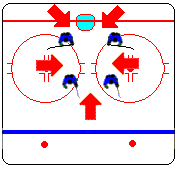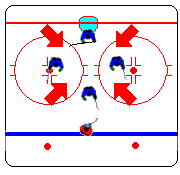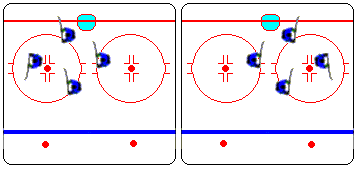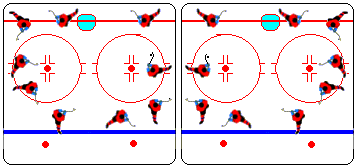
GAME THEORY CONCEPTS - PENALTY KILLING
Updated on the 22th of Juanuary
Penalty killing basically stands for; "while at a numerical disadvantage, keep the opposition from accessing good scoring lanes and locations while running off time on the penalty clock". The advantage of a "power play" is that it automatically provides the offensive team with a two on one opportunity at the onset. A power play breakout is designed to get the puck into the offensive zone either by carry or dump-in and keep or gain possession of the puck. The power play itself is designed to move the puck into a position that best utilizes offensive strengths, either individually or tactically and capitalizes on the weakness of the defending team, either skill-wise or positionally by creating two-on-one opportunities that open up quality scoring or passing lanes.
Penalty kill: Key questions:
1 - What breakout tactic do they use; Speed, Pick, Stretch, Gain center line, etc
2 - What preferred method do they utilize to gain offensive zone; Carry, Pass, Dump-in, etc.
3 - What part of the offensive zone do they try to utilize; High (point-"umbrella" for example), Down Low, Side wall to back-side, hi-slot, wrap-a-round, etc?
4 - What is their preferred method of creating two on ones; Single pass - drive, Two pass, Carry and Support.
5 - What is their preferred offensive tactic; Shot from point/screen-go to the net, Cross pass and one-time shot, Support low and back door pass, Corner draw and slot pass/shot, Go to the net, etc.
6 - Do they focus on a key player; Hard point shooting defenseman, Off-wing one time shooter, Play-maker down low, etc.
7 - Do they have confidence with the puck (able to control under pressure).
8 - Are they a good passing unit (keep the passes clean - no rims or bouncing passes).
Upon analysis of an opponents power play using the above information we can either assume one of two postures; positional or pressure.
Positional penalty killing is based on conventional numerical systems such as the 1-2-1(diamond), 2-2 (box), or unconventional systems such as the 1-1-2. as shown below on the far right. Each system has a particular advantage (from the PK standpoint) or disadvantage (from the PP standpoint).

A - The 2-2 system or standard box is the most common with players keeping tight formation. This PK system creates five attack lanes as shown below but forces the opposition into 3 on 2s horizontally (top of zone and bottom of zone - goal line) and vertically (side wall) as well as corner zones.

In the diagram below, I have shown 90 degree shifts in the box showing side wall protection, goal-line or down low and blueline/ top zone protection.

In the diagram below I have shown corner zone protection/rotation.

In the diagram below I have shown a simple rotation from corner to corner and the subsequent adjustment of the box.

B - The 1-2-1 system is to eliminate one attack lane to the net, protect the seam, eliminate high slot options but is weak down low unless D-man is good at blocking passing lanes. The basic concept is to create a 3 on 3 high and eliminate the seam shot. As shown below, this formation only allows 4 lanes to the net with down low options presenting the biggest threat.

In the diagrams below I have shown side wall protection using the diamond.

C - The 1-1-2 system which provides double coverage down low and in the slot and eliminates the shot from the seam. This system takes more practice since players switch often. This is a high pressure system down low and positional high. Low Rotation between Def and low forward is shown below.

C - The 1-1-2 system high rotation is shown below as a continuation of the above diagram. This system creates a 2/2 down (corner) or 3/3 down low leaving protection in the seam from a point shot.

As we can see, players rotate from a 1-2-2, to a 1-2-1, to even a 2-2. The main objective is protection from play options down low.
In the following pages I will provide a VERY in depth analysis of Penalty Killing systems but first some information to lead the charge.
Some interesting material has been by Mr. Chris Howerton. I would like to thank him for his contribution regarding the following articles and links.
When asked “what's the secret to the
Hurricanes' penalty kill?”[1],
Bret Hedican replied:
“Just hard work. Penalty killing isn't for
the glamorous guys, it's for the guys that really want to work. It's not
different than what this team is made of. We've got a bunch of hard workers.”
The main purpose of penalty killing is to deny the opposition scoring chances. Bjorn Kinding of Sweden did an interesting study of where power play goals are scored from. He found that about 30% of goals come from plays originating behind the goal line. Plays starting from the half boards account for about 10% of goals and 60% of goals come from shots or shot passes from the point. Bjorn noted that passes from behind the goal line and from the point only need to beat one defender, while plays from the half boards must beat at least two defenders.
These results are important when a coach decides where he is going to give up the 2 on 1 advantage inherent in a power play and whether to create pressure or simply contain, when his team is killing penalties:
WEST ORANGE, N.J.
(AP)
The Flyers enter Game 1 of the conference final on Sunday in Philadelphia with the NHL's top-ranked power play in the playoffs. They've converted on 13 of 52 chances with the extra man, or 25 percent.
Against New
Jersey, Philadelphia will be facing the top penalty killing unit in the
postseason. The Devils have killed off 33 of 34 short-handed chances, including
the last 23. Toronto failed on all
20 of its power plays against the Devils in the conference semifinal.
On the power play,
the Flyers try to get John LeClair in front of goaltender Martin Brodeur and get
shots from the points from defensemen Eric Desjardins and Andy Delmore, who has
scored five goals in 11 playoff games after having just two in 27 regular-season
contests. "They're a shooting
power play," Devils defenseman Scott Stevens said. "They have size in
front with LeClair and Primeau and they got (Mark) Recchi to set it up and they
got good shooters at the point. I think their main thing will be to get the puck
to the point and get it on net and get shots and tips."
The Devils will
use an aggressive approach to their penalty killing and it will start by trying
to keep Philadelphia out of the offensive zone.
Madden and Jay Pandolfo have been good at breaking up plays and Stevens
and Ken Daneyko have been stopping forwards trying to enter the zone.
That's forced opponents to dump the puck in a lot, which can be a major
mistake because Brodeur is probably the league's best puck-handling goalie. As
fast as the Maple Leafs dumped the puck in the Devils' zone, Brodeur flipped it
back out.
"When a team
pretty much has to think about where it's going to dump the puck while someone
is in their face, it's pretty hard to do," Stevens said. "You tend to
make mistakes. They know they have to keep the puck away from Marty. They will
try to hard around it, but Marty is good at grabbing the puck and getting it
out."
If Philadelphia
gets the puck into the offensive zone, the Devils will try to prevent the Flyers
from passing it around by attacking the puck carrier.
During the regular
season, the Devils won the special teams battle with the Flyers in winning four
of five games. Philadelphia, which converted on 20.3 percent of their power
plays in the regular season, was 2 of 21 with the man advantage against New
Jersey, or 9.5 percent. New Jersey
actually had a better power play, converting on 4 of 17, or 23.5 percent.
In other words, the best penalty kill can defeat the best power play.
In order to understand a penalty kill's success or lack thereof, we must first look at several different options that a power play has. The first one is the strength's/weaknesses associated with shooting hand (natural or off-wing). Take a look at the following diagram and think of possible advantages and disadvantages based on passing/reception and shooting relative to GT and checking pressure.

Now that I have the old mental juices flowing, take a look at the following diagrams below which represent natural to natural side passing (with one exception). What are the advantages and disadvantages?

Again, natural to natural side variations. Again, what are the obvious advantages and disadvantages.

Advantages/disadvantages (now that you have thought of a few) fall into one of, or a multiple of categories.
1 - pressure.
Hi zone checking pressure is more conservative that low zone pressure, half-wall pressure is different than corner pressure, corner pressure is different than pressuring behind the net. Look at the following diagrams.

In the first diagram, I have numbered the perimeter zones from 1 to 5. I like to call these zones the "set-up" zones. Due to defensive overlap responsibilites and distance from the net, players on the PP can gain control of the puck in these areas and "SET-UP" PP player options. In the second through fourth diagrams I have shown some passing / shooting lanes which are utilized when making plays close to the net on the Power Play. The success of these lanes depends considerably on the shooting hand of passing receiving players as well as receiving/shooting ability. In the diagram below, I have shown three examples of partner to partner passing options with a one-time shot as the shooting option utilizing lanes/space away from the net. These types of shooting options occur as a result of checking pressure type and distance away from the net (better known as critical space). This type of PP is usually run where the opposition utilizes a passive high-checking foreward (or maybe lazy or slow!!) and point/hi-corner players on offense have superior passing/shooting skills. One time shooting is a superior scoring skill due to the fact that it takes advantage of player confusion and GT movement. A one-time shot off this type of passing play is unpredictable and subsequently is hard to read. As well, the shot usually carries a great deal of velocity.

In the diagrams below, I have again focused on the one time shot as the preferred method of scoring but, due to the passing lanes utilized, a single pass/shot format must be used. Again, shooting hand is critical to success with the exception of the third diagram (shooting hand is redundant in most cases due to passing/shooting angle).

While there are other types of scoring (shot /deflection, switch and wrap-a-round, give-and-go/slot drive.) the above are the most common due to simplicity (KISS principle - Keep It Simple Stupid) and effectiveness. Depending on scoring ability of PP players above options may change (from off-wing to natural side shooters) but a considerable higher degree of shooting and passing skills must be demonstrated. It is important to note that when looking at the above PP types, a static puck carrier (standing still), pass and shot is unlikely (but not improbable depending on the skill level). Most often a multiple of touch/quick passes are utilized to create the final shot. Again, some more passing variations. In the diagrams below I have shown what is most often called a "two-pass" power play; pass/touch pass/shot. These options are possible because of PK player movement. Think about this for a moment. What type of PK movement (or lack thereof) would create the options shown in the above diagrams and the ones below (PLEASE Notice shooting hand and subsequent options).

If we look at the first sequence of passing plays shown above (natural side passes) then we can see how the "set-up" progresses into the options shown. The first option has the point and half wall passing to disrupt the box. Wide side player drives in and deflects puck. In the second option the setup involves the D - D pass to draw out the box/high man then quickly down low and over to back side. The third option is the half wall to point setup to draw out the aggressive defense-man, miss pass to corner and walk-out. Question is: how to stop this from happening? MORE LATER

Copyright © 1996 by Ron Johnson. All rights reserved.